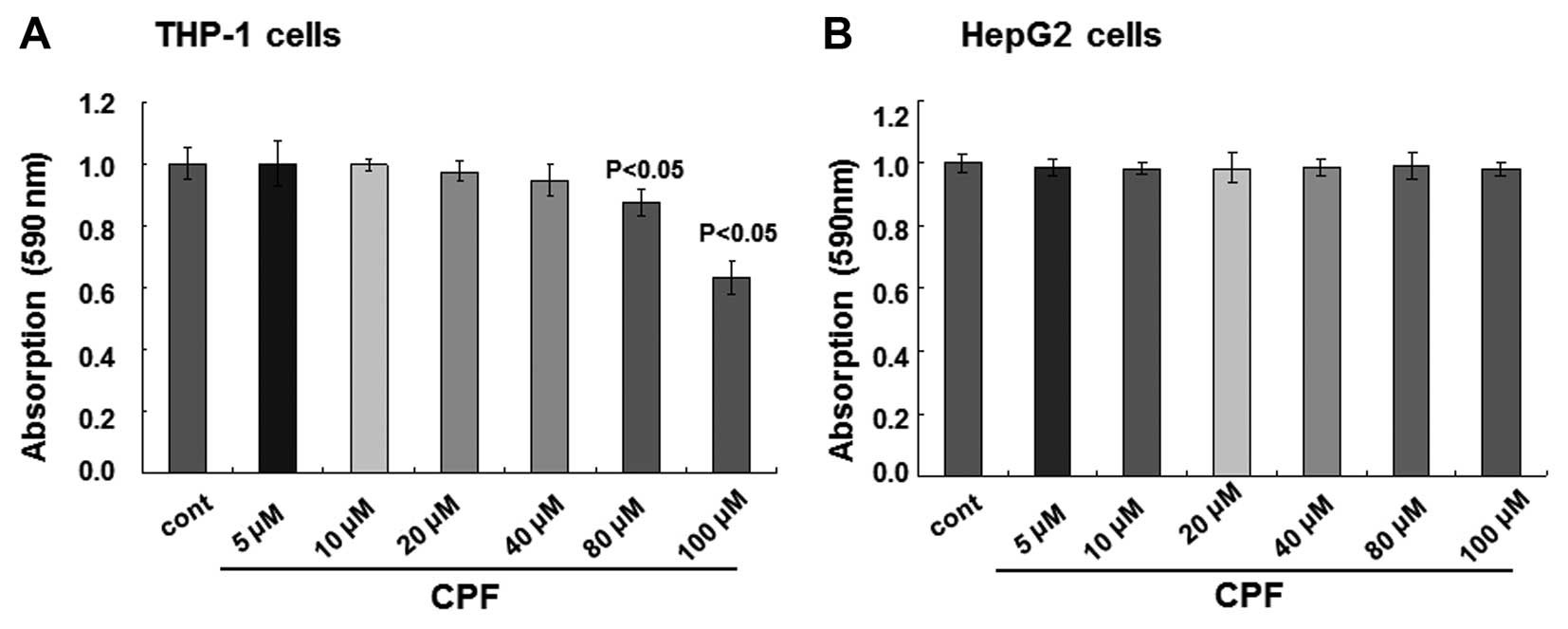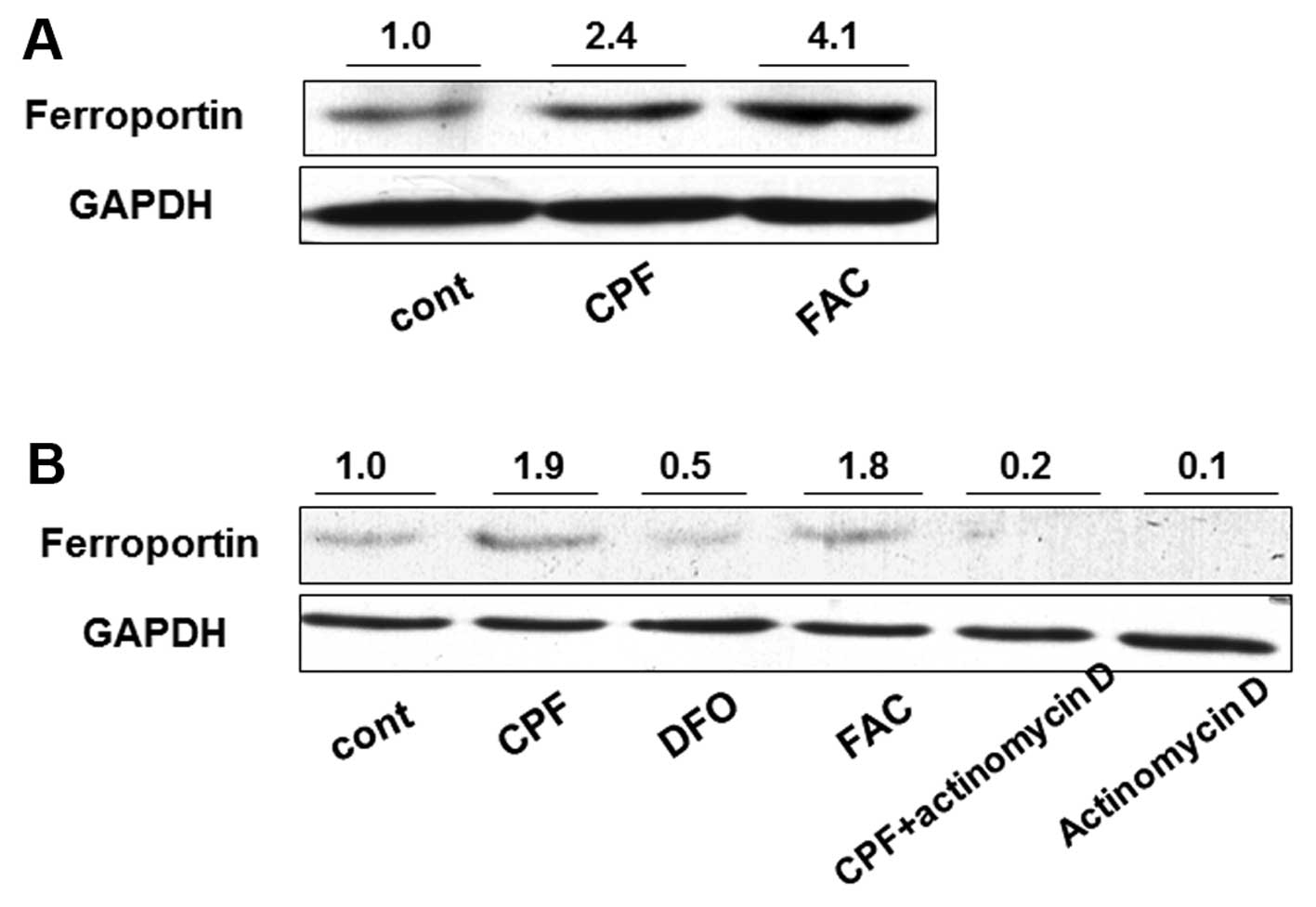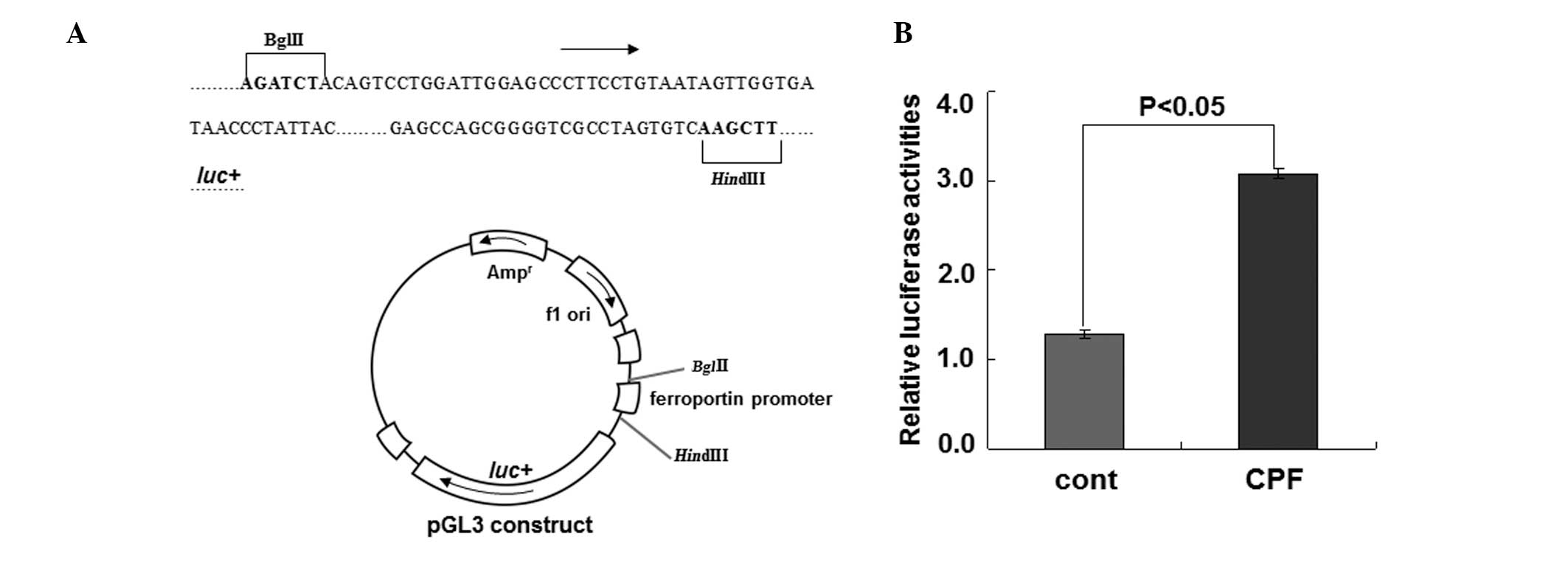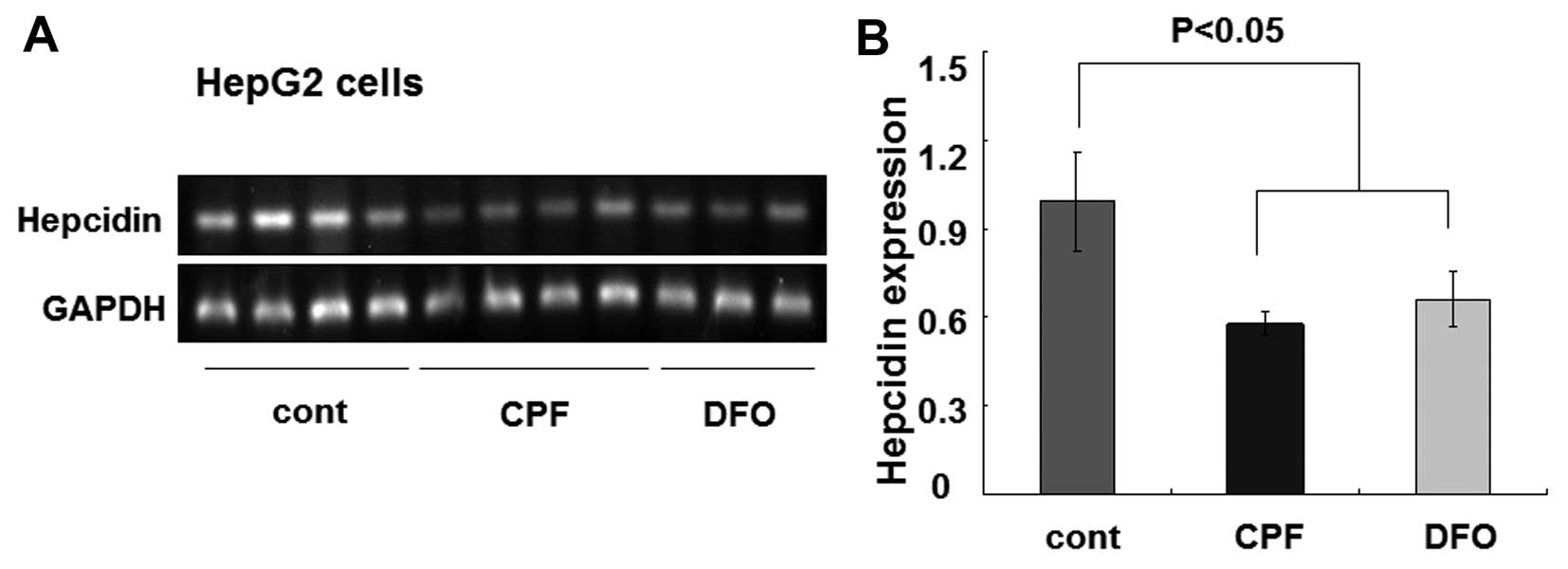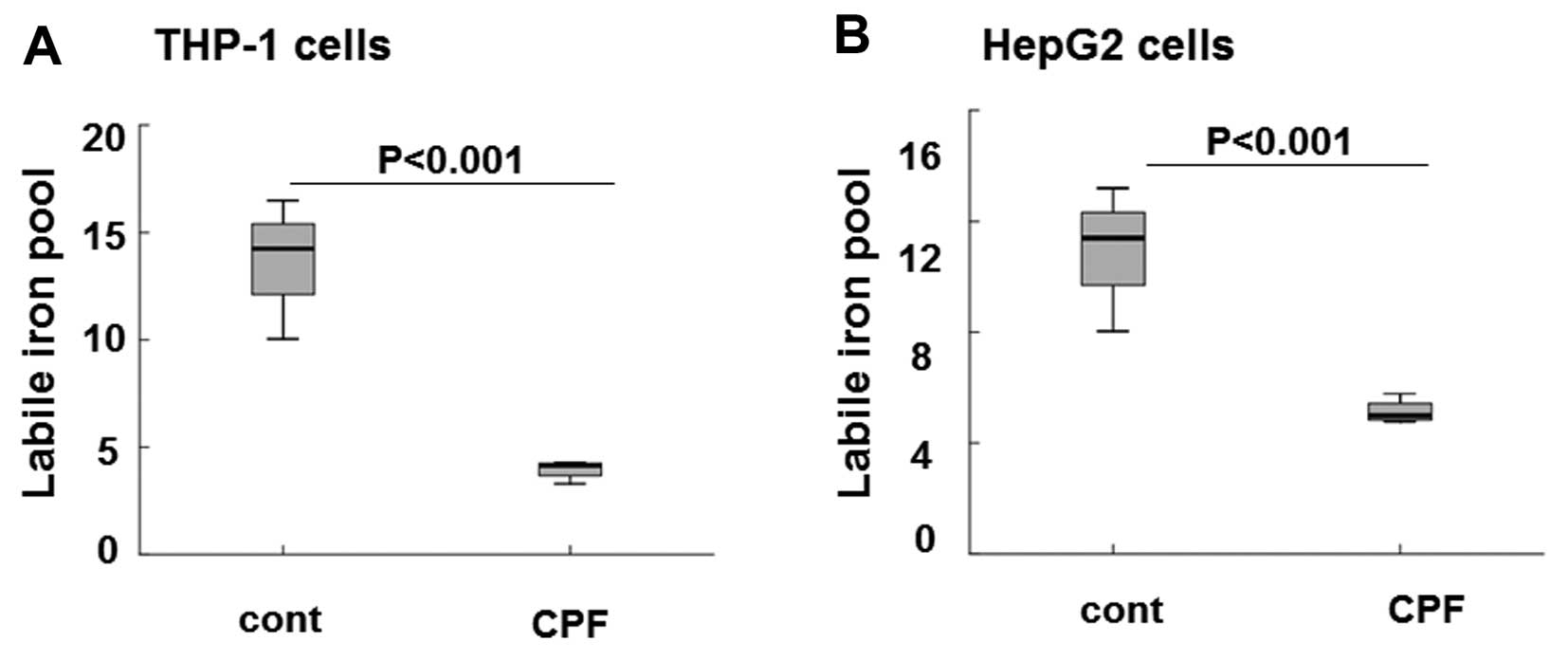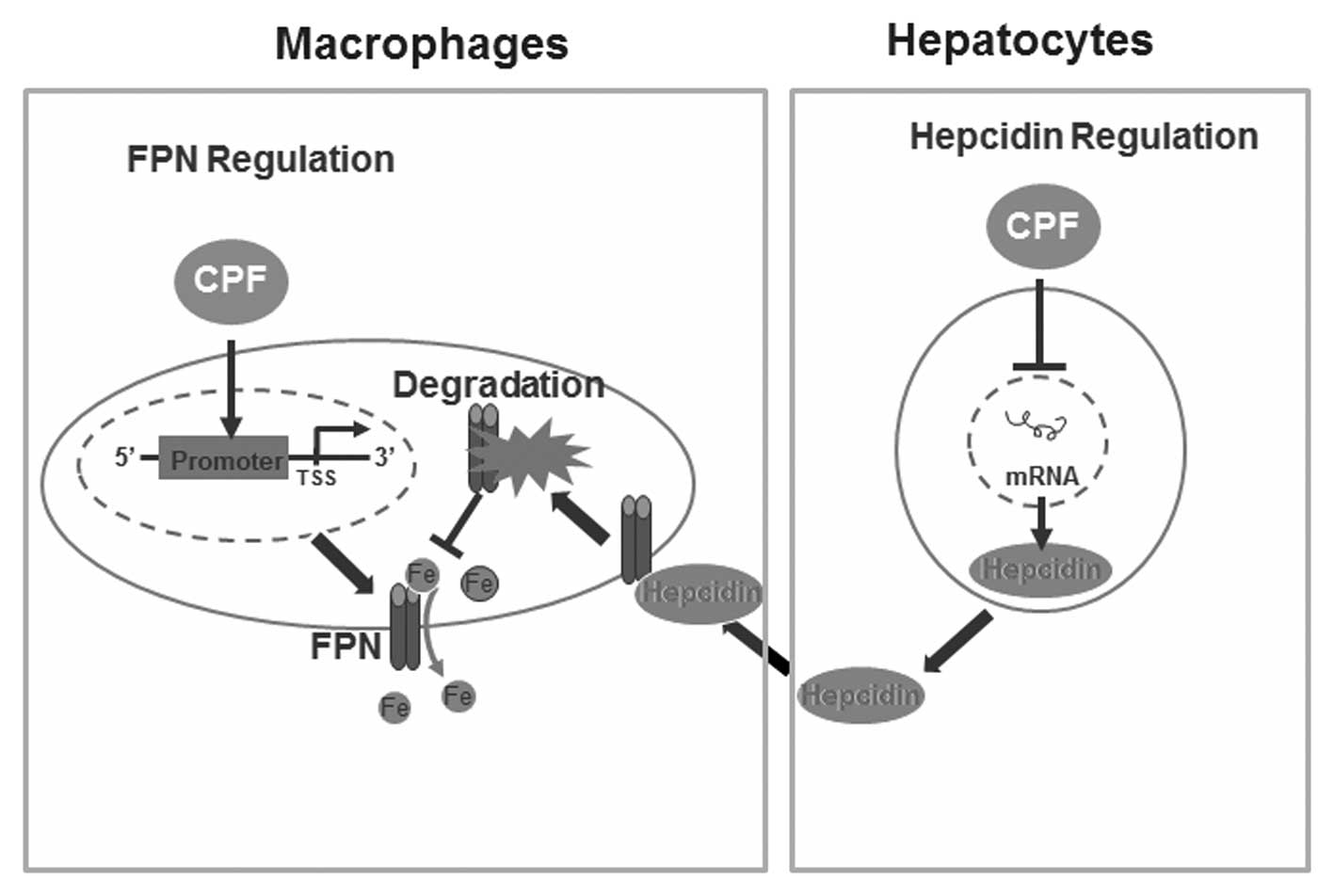Sublethal exposure of organophosphate pesticide chlorpyrifos alters cellular iron metabolism in hepatocytes and macrophages
- Authors:
- Published online on: August 18, 2014 https://doi.org/10.3892/ijmm.2014.1902
- Pages: 1395-1400
Abstract
Introduction
As one of the largest produced and used pesticides, chlorpyrifos (CPF) is widely distributed in various environmental media, and in fruits and vegetables (1–3). Numerous studies have suggested that CPF may elicit adverse effects on human health (4–6). Thus far, CFP is known as an acetylcholinesterase (AChE) inhibitor, and induces significant damage to the central nervous system (7). In addition to neurological toxicities, CFP has been found to induce reactive oxygen species (ROS), and thus cause DNA damage in several organs of animal models (8,9). Other studies have shown that CPF exposure is associated with developmental disorders, autoimmune disorders (10,11), and even cancers, such as lung and breast cancer (12,13). Moreover, histological examinations also show that CPF administration leads to substantial injury to liver, resulting in infiltration of macrophages in the portal area in an animal study (9).
Liver is the central organ governing systemic iron homeostasis, where hepcidin is primarily secreted by hepatocytes and regulates iron flux by interacting with its receptor ferroportin, which is associated with the internalization and degradation of ferroportin, thereby reducing iron egress from macrophages and iron absorption from the small intestine (14–16). Iron, an essential element, is important for a variety of biological processes (17,18). Systemic iron homeostasis is deliberately modulated by the hepcidin-ferroportin regulatory axis (14,19–21). Ferroportin is the only known mammalian iron exporter, mainly expressed in epithelial cells in duodenum and macrophages, and is critical for controlling iron egress (15,16). Through the hepcidin-ferroportin axis, downregulated hepatic hepcidin increases the serum iron level by promoting iron absorption from enterocytes in duodenum and iron release from macrophages (22). Increased ferroportin concentration enhances iron egress from cells, thereby decreasing intracellular iron (23).
However, studies available on CPF-conducted impairments to liver-centered iron homeostasis are currently limited, and the present literature even remains contradictory. Furthermore, little insight has been gained into potential effects of CPF on the hepcidin-ferroportin axis, and the molecular mechanisms responsible for CPF-mediated actions on iron metabolism remains to be clarified. To the best of our knowledge, in the present study, we demonstrated for the first time that CPF was able to disturb iron metabolism by enhancing ferroportin expression in macrophages and inhibiting hepcidin expression in hepatocytes at sublethal concentrations.
Materials and methods
Chemicals, reagents and cell culture
CPF was purchased from Shuangma Fine Chemical Co., Ltd. (Nantong, China) with the purity of >99.99%. The THP-1 human macrophage, HepG2 human hepatic carcinoma and HEK293T human embryonic kidney cell lines were obtained from the Shanghai Cell Bank of Type Culture Collection of Chinese Academy of Sciences. The cells were cultured in RPMI-1640 medium (Gibco) supplemented with 10% fetal bovine serum (FBS) and 100 U/ml penicillin/streptomycin (both from HyClone, Logan, UT, USA) in a humidified incubator (Thermo Fisher Scientific, Inc., Waltham, MA, USA) with 5% CO2 at 37°C. Differentiation of THP-1 cells into macrophages was induced with 1 μg/ml PMA (Promega, Madison, WI, USA) in complete medium for 18 h.
Alamar blue assay
Cell viability was determined through the Alamar blue assay according to the manufacturer’s instructions (Thermo Fisher Scientific, Inc.). Briefly, THP-1 and HepG2 cells were seeded in 96-well plates at a concentration of 5.0×103 cells/well. The cells were then treated with CPF for 24 h, followed by emission detection at 590 nm with excitation at 530 nm.
Western blotting
Cells were harvested and washed twice with cold phosphate-buffered saline (PBS). Total proteins were then extracted with RIPA lysis buffer (Solarbio, Beijing, China) supplemented with protease inhibitor cocktail (Roche Applied Science, San Francisco, CA, USA). Equal amounts of protein lysates (30–50 μg/sample) were subjected to 10% SDS-PAGE and western blot analysis was performed as described previously (24). Antibodies included anti-ferroprotin (1:500; Sigma-Aldrich, St. Louis, MO, USA) and anti-glyceraldehyde 3-phosphate dehydrogenase (GAPDH) (1:1,000; Santa Cruz Biotechnology, Inc., Santa Cruz, CA, USA). Intensity of bands was assessed with the ImageJ software (http://rsb.info.nih.gov/ij/). GAPDH was used as an internal control for normalization.
RNA extraction and RT-PCR analysis
Total RNAs were isolated from cells with TRIzol according to the manufacturer’s instructions (Invitrogen Life Technologies, Carlsbad, CA, USA). The first strand of cDNA was synthesized from 2 μg total RNAs using oligo(dT) primer. Primer sequences used for the PCR reaction were: hepcidin, 5′-CCTGACCAGTGGCTCTGTTT-3′ (forward) and 5′-CACATCCCACACTTTGATCG-3′ (reverse); GAPDH, 5′-GAAGGTGAAGGTCGGAGT-3′ (forward) and 5′-GAAGATGGTGATGGGATTTC-3′ (reverse). GAPDH was used as an internal control.
Luciferase reporter assays
A DNA fragment with ferroportin promoter region was subcloned into the pGL3-Promoter luciferase reporter vector (Promega) to replace the SV40 promoter. The final construct was validated by DNA sequencing (Invitrogen). Then, 0.8 μg target construct plus 80 ng Renilla luciferase construct were co-transfected into HEK293T cells in 24-well plates using Lipofectamine™ 2000 (Invitrogen). After 24 h, the cells were washed with PBS, and assayed for luciferase activity using a dual-luciferase reporter assay system according to the manufacturer’s instructions (Promega). Relative firefly luciferase activities were subsequently normalized to those of Renilla luciferase.
Labile iron pool (LIP) assay
Intracellular LIP was measured as previously described (25). Briefly, the cells were collected and washed following treatments, and subsequently incubated with 0.5 μM calcein acetoxymethyl ester (CA-AM) (Sigma-Aldrich) for 15 min at 37°C. After washing with PBS, the cells were equally divided into two groups. One group was treated with 100 μM desferoxamine (DFO; Sigma-Aldrich) for 1 h at 37°C, and the second group was left untreated. The cells were subjected to FACS analysis (FACSCalibur; BD Biosciences, San Jose, CA, USA), where calcein was excited at 488 nm and measured at 525 nm. Intracellular LIP was obtained through deduction of the cellular fluorescence of DFO-treated cells from that of the untreated cells.
Statistical analysis
Significance of data between two groups was determined by the two-tailed independent t-test. One-way analysis of variance (ANOVA) was employed to assess the mean differences among groups relative to the control. Experimental data were shown as mean ± standard error (SE). P<0.05 was considered to indicate a statistically significant result.
Results
Cytotoxicity following CPF treatment in macrophages and hepatocytes
To examine the potential effects of CPF exposure on iron metabolism, two cardinal types of cells were employed to determine systemic iron flux, macrophages and hepatocytes (16,26,27). The THP-1 human macrophage and HepG2 human hepatic carcinoma cell lines were used. In order to dissect the non-toxicity biological effects from cytotoxicity, in other words, to focus on the biological effects of CPF without exerting significant injuries on cells, concentrations that did not induce significant toxicity to cells were initially obtained. THP-1 and HepG2 cells were treated with different concentrations of CPF for 24 h, and cell viabilities were measured using the Alamar blue assay. No alterations of cell viability were observed when the concentrations of CPF were <80 μM for THP-1 cells, while cell viability was reduced >10% at 80 μM (P<0.05) and subsequently reduced by >30% at 100 μM (P<0.05) (Fig. 1A). With respect to HepG2 cells, no detectable cytotoxicity occurred when the cells were treated with CPF up to 100 μM CPF (P>0.05) (Fig. 1B). Therefore, in the present study, a non-toxic (i.e., sublethal) concentration, 20 μM, was selected for the subsequent experiments. Notably, the medium of 20 μM CPF contained 0.001% DMSO only. Medium with 0.001% DMSO caused no toxicity to cells compared to the complete blank control, and it served as a control in the present study (designated as control or cont in the text and figures).
CFP elevates ferroportin expression through transcriptional regulation
Ferroportin is the only known iron exporter in mammal animals, and its dysfunction is involved in various iron disorders, such as thalassemias and hemochromatosis (16,27,28). We therefore investigated the effect of CPF treatment on ferroportin concentration in THP-1 macrophages. Following treatment with CPF at 20 μM for 24 h, the ferroportin concentration was significantly induced by >2-fold in CPF-treated cells compared to the untreated cells (Fig. 2A). Ferric ammonium citrate (FAC) (100 μM), as a positive control, was used to increase ferroportin concentration (29) (Fig. 2A). To investigate the mechanism underlying the increase of ferroportin concentration, a transcription inhibitor, actinomycin D, was used to attenuate global mRNA transcription. Actinomycin D treatment alone greatly reduced ferroportin concentration in THP-1 cells, suggesting marked transcriptional inhibition by actinomycin D (Fig. 2B). The increase of ferroportin concentration by CPF was markedly reduced when cells were simultaneously treated with actinomycin D compared to that in cells treated with CPF only (Fig. 2B). The ferroportin concentration in the cells treated with CPF + actinomycin D was greater than that in the cells treated with actinomycin D only (Fig. 2B). These results suggested that CPF promoted the ferroportin level through a transcriptional regulatory mechanism. FAC was used as a positive control to elevate ferroportin, and DFO (100 μM), a negative control (30), was used to impede the ferroportin increase (Fig. 2B).
To substantiate the regulation of ferroportin by CPF at the transcriptional level, we performed the luciferase reporter assay to examine ferroportin expression driven by its own promoter upon CPF (Fig. 3). Following exposure to CFP at 20 μM for 24 h in HEK293T cells, luciferase activity was measured. Compared to the control, CPF treatment increased luciferase activity by ~2.5-fold (P<0.05) (Fig. 3), supporting the transcriptional regulation of ferroportin by CPF. These data together identified a novel effect of CPF on promoting ferroportin expression in macrophages.
CPF inhibits hepatic hepcidin expression
To understand the biological effects of CPF on iron metabolism, hepatic hepcidin expression was investigated. As the master regulator of systemic iron homeostasis, hepcidin is predominantly secreted by hepatocytes (31). Additionally, hepcidin directs iron flow by suppressing ferroportin-conducted iron release (32). Hepcidin reduction is associated with increased iron egress and intracellular iron depletion. HepG2 cells were similarly treated with CPF at 20 μM. After 24 h, we found that the hepcidin mRNA level was greatly reduced by CPF (Fig. 4A). The quantified data showed an ~50% reduction of the hepcidin mRNA level in CPF-treated cells relative to the untreated cells (P<0.05) (Fig. 4B). Consistent with previous studies (33), DFO was used as a control to inhibit hepcidin expression (P<0.05) (Fig. 4). These results demonstrated a considerable inhibitory effect of CPF on hepatic hepcidin expression.
Decreased LIP following CFP treatment in macrophages and hepatocytes
The available section of intercellular iron occurred in loosely-bound divalent iron form (i.e., LIP). It was readily and rapidly involved in the synthesis of iron-sulfur clusters, heme and other iron-containing proteins (34,35). LIP was largely determined by the concentrations of iron exporter ferroportin and iron-storage protein ferritin (35). Thus, the intracellular iron concentration was sensitively reflected by the availability and abundance of cellular LIP. To elucidate the consequential effects on iron storage following CPF exposure in THP-1 and HepG2 cells, we assayed LIP in the two types of cells following CPF treatment at 20 μM for 24 h. As shown in Fig. 5A the level of intracellular LIP was markedly reduced by ~3-fold in THP-1 cells in CPF-treated cells relative to the untreated cells (P<0.001), consistent with the significant induction of ferroportin subsequent to CPF treatment (Fig. 2). The level of intracellular LIP was greatly reduced by >2-fold in HepG2 cells treated with CPF compared to the untreated cells (Fig. 5B) (P<0.001), concomitant to hepcidin reduction in these cells following CPF (Fig. 4). These data signified the biological consequences of CPF on iron flow in macrophages and hepatocytes, by modulating ferroportin and hepcidin expression, respectively.
Discussion
When CPF is uptaken, it may accumulate in various organs, such as liver, kidney, ovary and uterus (36–38), with liver being one of the preferential targets (39). Long-term exposure to CPF results in significant histopathological alterations to liver, including hepatocytic vacuolation, sinusoidal dilation and focal necrosis (40). The potential non-toxic biological effects of CPF on liver, i.e., changes of biological functions without significant cytotoxicity, has been been recognized. Hepatocytes and macrophages, synergistically play a pivotal role in governing systemic iron homeostasis (41). In the present study, we identified a novel effect of CFP treatment on iron flow by altering the iron gene expression in hepatocytes and macrophages. Hepcidin expression was inhibited in HepG2 hepatocytes following CPF treatment, accompanied by reduced LIP, while ferroportin expression was elevated in THP-1 macrophages following CPF treatment, which was associated with LIP reduction.
Reticuloendothelial macrophages are the most important cells for iron storage, as they are involved in aborbing senescent red blood cells to recycle iron for erythropoiesis (42), where ferroportin, as the only known iron exporter, controls iron egress out of macrophages (43). An increased ferroportin concentration enhances iron release and reduces intracellular iron storage, as evidenced by LIP reduction (44,45). In the present study, we demonstrate that CPF exposure increased ferroportin concentration in THP-1 macrophages, and this increase was mainly due to the upregulation of ferroportin transcription. As a result of the ferroportin increase, the available iron content as reflected by LIP was reduced in THP-1 macrophages. By contrast, we identified a reduced hepatic hepcidin expression in HepG2 hepatocytes following CPF treatment, which led to a reduced intracellular iron level as evidenced by LIP reduction presumably due to the hepcidin-induced degradation of ferroportin in hepatocytes. These results suggest that CPF exposure elicited significant changes to cellular iron homeostasis by regulating hepcidin and ferroportin expression in macrophages and hepatocytes. The detailed mechanisms underlying CPF-promoted activity in transcribing ferroportin and CPF-mediated hepcidin repression should be further investigated.
In conclusion, results of the present study have identified a novel finding of CPF in altering cellular iron homeostasis without imparing cell viability. We have demonstrated that CPF exposure significantly altered the expression of central iron genes, i.e., CPF elevates ferroportin expression in macrophages and represses hepcidin expression in hepatocytes, coupled with LIP reduction in macrophages and hepatocytes. A proposed schematic diagram deciphering the mechanisms responsible for CPF-induced alterations to cellular iron homeostasis is presented in Fig. 6.
Acknowledgements
This study was supported by a grant under the national ‘973’ program (grant no. 2014CB932000) and the National Natural Science Foundation of China (grant no. 21377159). We would like to thank the laboratory members for their great assistance with the experiments and reagents.
References
|
Zhao L, Wang F and Zhao J: Identification and functional characteristics of chlorpyrifos-degrading and plant growth promoting bacterium Acinetobacter calcoaceticus. J Basic Microbiol. May 26–2013.(Epub ahead of print). | |
|
Kumar Singh B, Walker A and Wright DJ: Persistence of chlorpyrifos, fenamiphos, chlorothalonil, and pendimethalin in soil and their effects on soil microbial characteristics. Bull Environ Contam Toxicol. 69:181–188. 2002.PubMed/NCBI | |
|
Gebremariam SY, Beutel MW, Yonge DR, Flury M and Harsh JB: Adsorption and desorption of chlorpyrifos to soils and sediments. Rev Environ Contam Toxicol. 215:123–175. 2012.PubMed/NCBI | |
|
Mink PJ, Kimmel CA and Li AA: Potential effects of chlorpyrifos on fetal growth outcomes: implications for risk assessment. J Toxicol Environ Health B Crit Rev. 15:281–316. 2012. View Article : Google Scholar : PubMed/NCBI | |
|
Ridano ME, Racca AC, Flores-Martin J, et al: Chlorpyrifos modifies the expression of genes involved in human placental function. Reprod Toxicol. 33:331–338. 2012. View Article : Google Scholar : PubMed/NCBI | |
|
Singh S, Kumar V, Thakur S, et al: DNA damage and cholinesterase activity in occupational workers exposed to pesticides. Environ Toxicol Pharmacol. 31:278–285. 2011. View Article : Google Scholar : PubMed/NCBI | |
|
Sandahl JF, Baldwin DH, Jenkins JJ and Scholz NL: Comparative thresholds for acetylcholinesterase inhibition and behavioral impairment in coho salmon exposed to chlorpyrifos. Environ Toxicol Chem. 24:136–145. 2005. View Article : Google Scholar : PubMed/NCBI | |
|
Gupta SC, Mishra M, Sharma A, et al: Chlorpyrifos induces apoptosis and DNA damage in Drosophila through generation of reactive oxygen species. Ecotoxicol Environ Saf. 73:1415–1423. 2010. View Article : Google Scholar : PubMed/NCBI | |
|
Ojha A, Yaduvanshi SK, Pant SC, Lomash V and Srivastava N: Evaluation of DNA damage and cytotoxicity induced by three commonly used organophosphate pesticides individually and in mixture, in rat tissues. Environ Toxicol. 28:543–552. 2013. View Article : Google Scholar : PubMed/NCBI | |
|
Gralewicz S: Possible consequences of AChE inhibition in organophosphate poisoning. A new approach to an old problem. Med Pr. 48:469–472. 1997.(In Polish). | |
|
Fu Y, Li M, Liu C, et al: Effect of atrazine and chlorpyrifos exposure on cytochrome P450 contents and enzyme activities in common carp gills. Ecotoxicol Environ Saf. 94:28–36. 2013. View Article : Google Scholar : PubMed/NCBI | |
|
Lee WJ, Blair A, Hoppin JA, et al: Cancer incidence among pesticide applicators exposed to chlorpyrifos in the Agricultural Health Study. J Natl Cancer Inst. 96:1781–1789. 2004. View Article : Google Scholar : PubMed/NCBI | |
|
Ventura C, Núñez M, Miret N, et al: Differential mechanisms of action are involved in chlorpyrifos effects in estrogen-dependent or -independent breast cancer cells exposed to low or high concentrations of the pesticide. Toxicol Lett. 213:184–193. 2012. View Article : Google Scholar | |
|
Ganz T: Hepcidin and iron regulation, 10 years later. Blood. 117:4425–4433. 2011.PubMed/NCBI | |
|
Jelić M1, Cvetković T, Djordjević V, et al: Hepcidin and iron metabolism disorders in patients with chronic kidney disease. Vojnosanit Pregl. 70:368–373. 2013.PubMed/NCBI | |
|
Pinnix ZK, Miller LD, Wang W, et al: Ferroportin and iron regulation in breast cancer progression and prognosis. Sci Transl Med. 2:43ra562010. View Article : Google Scholar : PubMed/NCBI | |
|
Sheftel A, Stehling O and Lill R: Iron-sulfur proteins in health and disease. Trends Endocrinol Metab. 21:302–314. 2010. View Article : Google Scholar | |
|
Frossard E, Bucher M, Machler F, Mozafar A and Hurrell R: Potential for increasing the content and bioavailability of Fe, Zn and Ca in plants for human nutrition. J Sci Food Agric. 80:861–879. 2000. View Article : Google Scholar | |
|
Andrews NC: Forging a field: the golden age of iron biology. Blood. 112:219–230. 2008. View Article : Google Scholar : PubMed/NCBI | |
|
Hentze MW, Muckenthaler MU, Galy B and Camaschella C: Two to tango: regulation of Mammalian iron metabolism. Cell. 142:24–38. 2010. View Article : Google Scholar : PubMed/NCBI | |
|
Knutson MD: Iron-sensing proteins that regulate hepcidin and enteric iron absorption. Annu Rev Nutr. 30:149–171. 2010. View Article : Google Scholar : PubMed/NCBI | |
|
Ganz T and Nemeth E: Hepcidin and disorders of iron metabolism. Annu Rev Med. 62:347–360. 2011. View Article : Google Scholar : PubMed/NCBI | |
|
Donovan A, Lima CA, Pinkus JL, et al: The iron exporter ferroportin/Slc40a1 is essential for iron homeostasis. Cell Metab. 1:191–200. 2005. View Article : Google Scholar : PubMed/NCBI | |
|
Qu G, Zhang C, Yuan L, et al: Quantum dots impair macrophagic morphology and the ability of phagocytosis by inhibiting the Rho-associated kinase signaling. Nanoscale. 4:2239–2244. 2012. View Article : Google Scholar : PubMed/NCBI | |
|
Prus E and Fibach E: Flow cytometry measurement of the labile iron pool in human hematopoietic cells. Cytometry A. 73:22–27. 2008. View Article : Google Scholar : PubMed/NCBI | |
|
Hentze MW, Muckenthaler MU and Andrews NC: Balancing acts: molecular control of mammalian iron metabolism. Cell. 117:285–297. 2004. View Article : Google Scholar : PubMed/NCBI | |
|
Nemeth E, Tuttle MS, Powelson J, et al: Hepcidin regulates cellular iron efflux by binding to ferroportin and inducing its internalization. Science. 306:2090–2093. 2004. View Article : Google Scholar : PubMed/NCBI | |
|
Singh B, Arora S, Agrawal P and Gupta SK: Hepcidin: a novel peptide hormone regulating iron metabolism. Clin Chim Acta. 412:823–830. 2011. View Article : Google Scholar : PubMed/NCBI | |
|
Doyard M, Fatih N, Monnier A, et al: Iron excess limits HHIPL-2 gene expression and decreases osteoblastic activity in human MG-63 cells. Osteoporos Int. 23:2435–2445. 2012. View Article : Google Scholar : PubMed/NCBI | |
|
Beutler E, Hoffbrand AV and Cook JD: Iron deficiency and overload. Hematol Am Soc Hematol Educ Program. 2003:40–61. 2003. View Article : Google Scholar | |
|
Park CH, Valore EV, Waring AJ and Ganz T: Hepcidin, a urinary antimicrobial peptide synthesized in the liver. J Biol Chem. 276:7806–7810. 2001. View Article : Google Scholar : PubMed/NCBI | |
|
Nicolas G, Viatte L, Bennoun M, Beaumont C, Kahn A and Vaulont S: Hepcidin, a new iron regulatory peptide. Blood Cells Mol Dis. 29:327–335. 2002. View Article : Google Scholar : PubMed/NCBI | |
|
Gehrke SG, Kulaksiz H, Herrmann T, et al: Expression of hepcidin in hereditary hemochromatosis: evidence for a regulation in response to the serum transferrin saturation and to non-transferrin-bound iron. Blood. 102:371–376. 2003. View Article : Google Scholar : PubMed/NCBI | |
|
Kakhlon O and Cabantchik ZI: The labile iron pool: characterization, measurement, and participation in cellular processes(1). Free Radic Biol Med. 33:1037–1046. 2002.PubMed/NCBI | |
|
Breuer W, Shvartsman M and Cabantchik ZI: Intracellular labile iron. Int J Biochem Cell Biol. 40:350–354. 2008. View Article : Google Scholar | |
|
Nishi K and Hundal SS: Chlorpyrifos induced toxicity in reproductive organs of female Wistar rats. Food Chem Toxicol. 62:732–738. 2013. View Article : Google Scholar : PubMed/NCBI | |
|
Xing H, Wu H, Sun G, Zhang Z, Xu S and Li S: Alterations in activity and mRNA expression of acetylcholinesterase in the liver, kidney and gill of common carp exposed to atrazine and chlorpyrifos. Environ Toxicol Pharmacol. 35:47–54. 2013. View Article : Google Scholar : PubMed/NCBI | |
|
Xing H, Li S and Wang X, Gao X, Xu S and Wang X: Effects of atrazine and chlorpyrifos on the mRNA levels of HSP70 and HSC70 in the liver, brain, kidney and gill of common carp (Cyprinus carpio L.). Chemosphere. 90:910–916. 2013. View Article : Google Scholar : PubMed/NCBI | |
|
Acker CI, Souza AC, Dos Santos MP, Mazzanti CM and Nogueira CW: Diphenyl diselenide attenuates hepatic and hematologic toxicity induced by chlorpyrifos acute exposure in rats. Environ Sci Pollut Res Int. 19:3481–3490. 2012. View Article : Google Scholar : PubMed/NCBI | |
|
Tuzmen N, Candan N, Kaya E and Demiryas N: Biochemical effects of chlorpyrifos and deltamethrin on altered antioxidative defense mechanisms and lipid peroxidation in rat liver. Cell Biochem Funct. 26:119–124. 2008. View Article : Google Scholar : PubMed/NCBI | |
|
Evstatiev R and Gasche C: Iron sensing and signalling. Gut. 61:933–952. 2012. View Article : Google Scholar | |
|
Kong WN, Lei YH and Chang YZ: The regulation of iron metabolism in the mononuclear phagocyte system. Expert Rev Hematol. 6:411–418. 2013. View Article : Google Scholar : PubMed/NCBI | |
|
Zhang Z, Zhang F, Guo X, An P, Tao Y and Wang F: Ferroportin1 in hepatocytes and macrophages is required for the efficient mobilization of body iron stores in mice. Hepatology. 56:961–971. 2012. View Article : Google Scholar : PubMed/NCBI | |
|
Galli A, Bergamaschi G, Recalde H, et al: Ferroportin gene silencing induces iron retention and enhances ferritin synthesis in human macrophages. Br J Haematol. 127:598–603. 2004. View Article : Google Scholar : PubMed/NCBI | |
|
Zhang DL, Senecal T, Ghosh MC, Ollivierre-Wilson H, Tu T and Rouault TA: Hepcidin regulates ferroportin expression and intracellular iron homeostasis of erythroblasts. Blood. 118:2868–2877. 2011. View Article : Google Scholar : PubMed/NCBI |



